Marketing Techniques, Limitations, and Research: TFL & Thomas Cook
VerifiedAdded on 2020/06/05
|10
|2857
|40
Report
AI Summary
This report provides an in-depth analysis of the marketing techniques employed by Transport for London (TfL) and Thomas Cook. It begins with an overview of marketing techniques, including the Ansoff matrix for TfL and branding, brand extension, and relationship marketing for Thomas Cook. The report then discusses the limitations and constraints of marketing, such as the Sale of Goods Act and the Data Protection Act. It further explores how Thomas Cook utilizes marketing research, encompassing primary and secondary research methods like surveys and interviews, and its application in marketing planning through SWOT and PESTLE analyses, and the use of SMART objectives. The report also examines market segmentation strategies, highlighting how TfL and Thomas Cook target specific customer groups based on demographic, psychographic, and geographic factors. Finally, it delves into the development of the marketing mix (product, price, place, and promotion) for Thomas Cook, providing insights into their product portfolio, distribution, pricing strategies, and promotional activities. This report offers a comprehensive understanding of the marketing approaches of these two organizations.
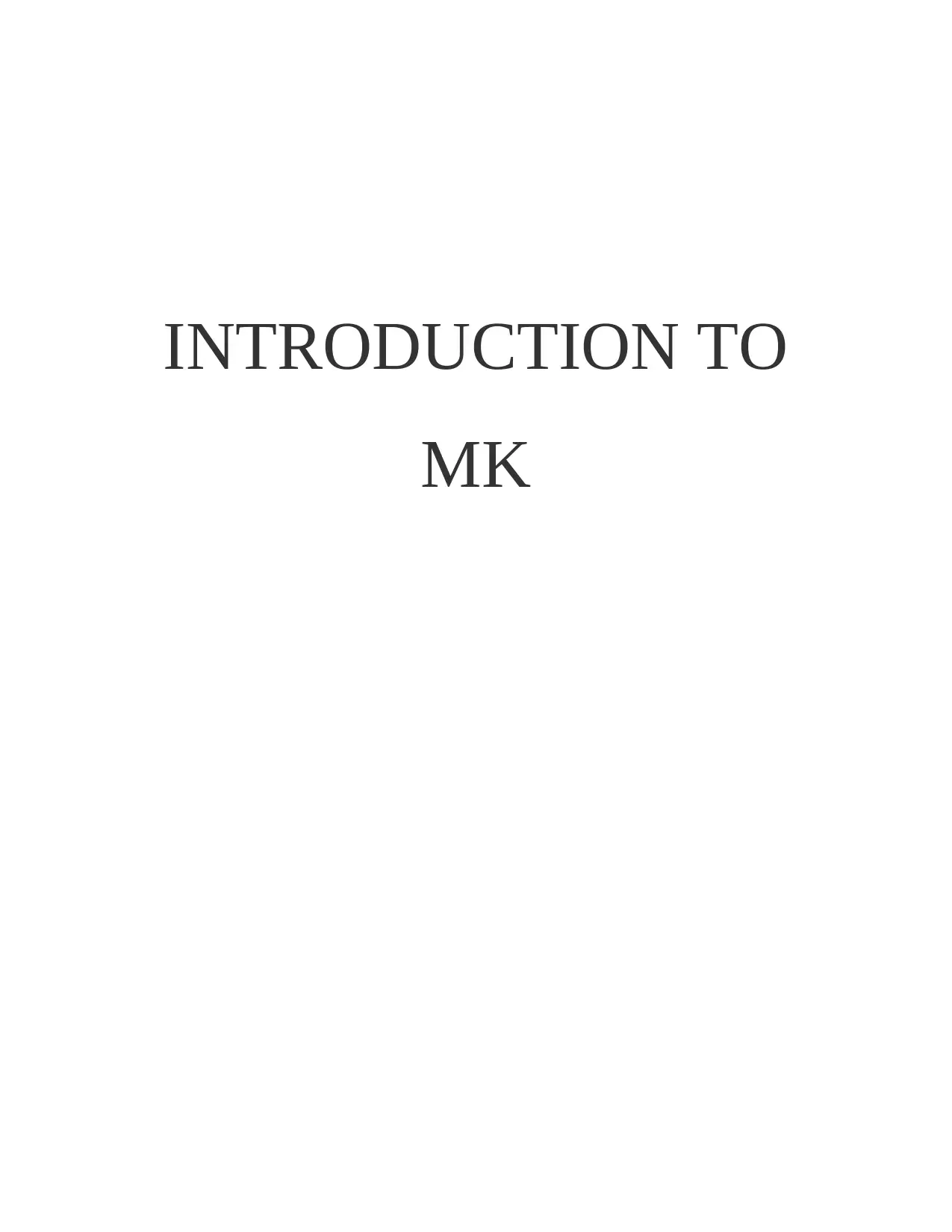
INTRODUCTION TO
MK
MK
Paraphrase This Document
Need a fresh take? Get an instant paraphrase of this document with our AI Paraphraser
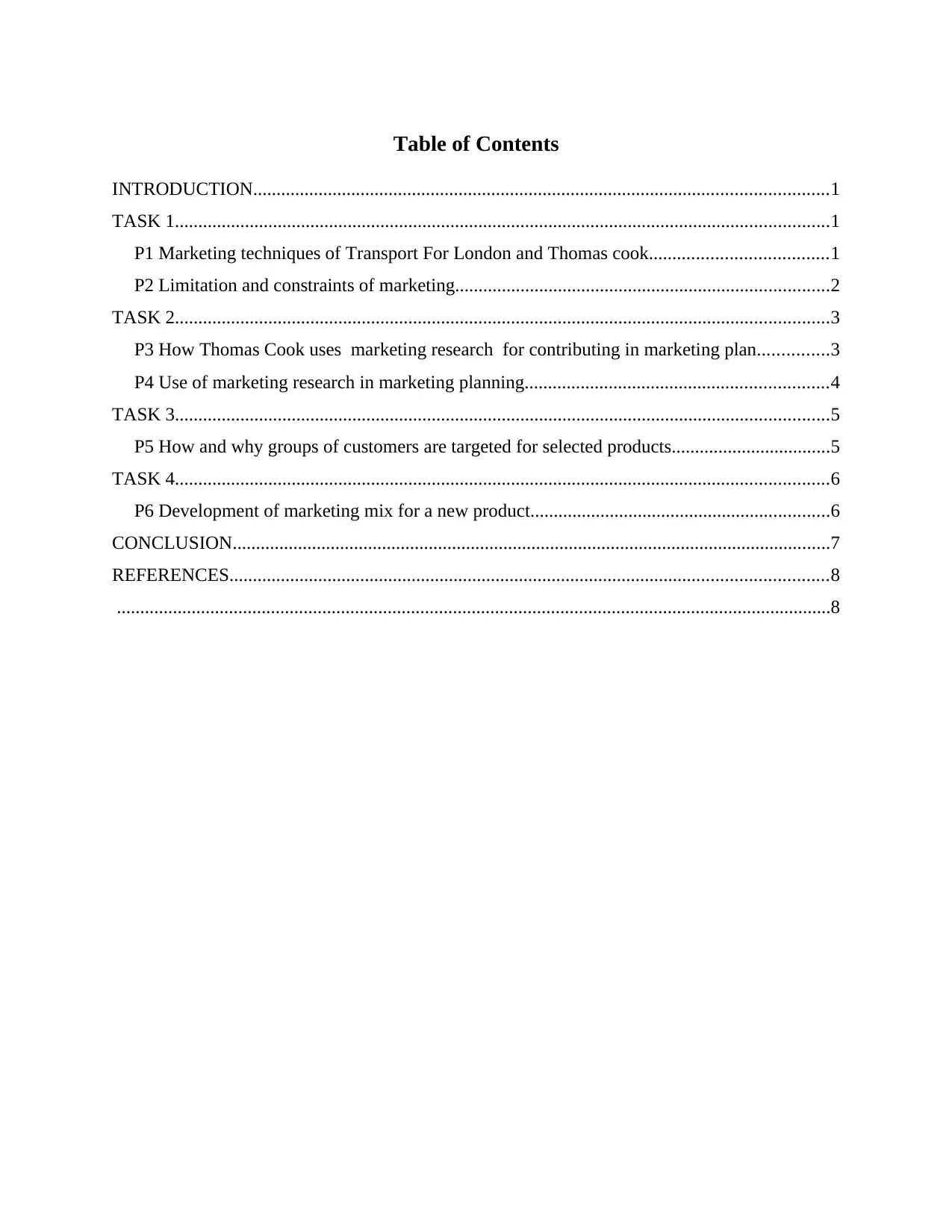
Table of Contents
INTRODUCTION...........................................................................................................................1
TASK 1............................................................................................................................................1
P1 Marketing techniques of Transport For London and Thomas cook......................................1
P2 Limitation and constraints of marketing................................................................................2
TASK 2............................................................................................................................................3
P3 How Thomas Cook uses marketing research for contributing in marketing plan...............3
P4 Use of marketing research in marketing planning.................................................................4
TASK 3............................................................................................................................................5
P5 How and why groups of customers are targeted for selected products..................................5
TASK 4............................................................................................................................................6
P6 Development of marketing mix for a new product................................................................6
CONCLUSION................................................................................................................................7
REFERENCES................................................................................................................................8
.........................................................................................................................................................8
INTRODUCTION...........................................................................................................................1
TASK 1............................................................................................................................................1
P1 Marketing techniques of Transport For London and Thomas cook......................................1
P2 Limitation and constraints of marketing................................................................................2
TASK 2............................................................................................................................................3
P3 How Thomas Cook uses marketing research for contributing in marketing plan...............3
P4 Use of marketing research in marketing planning.................................................................4
TASK 3............................................................................................................................................5
P5 How and why groups of customers are targeted for selected products..................................5
TASK 4............................................................................................................................................6
P6 Development of marketing mix for a new product................................................................6
CONCLUSION................................................................................................................................7
REFERENCES................................................................................................................................8
.........................................................................................................................................................8
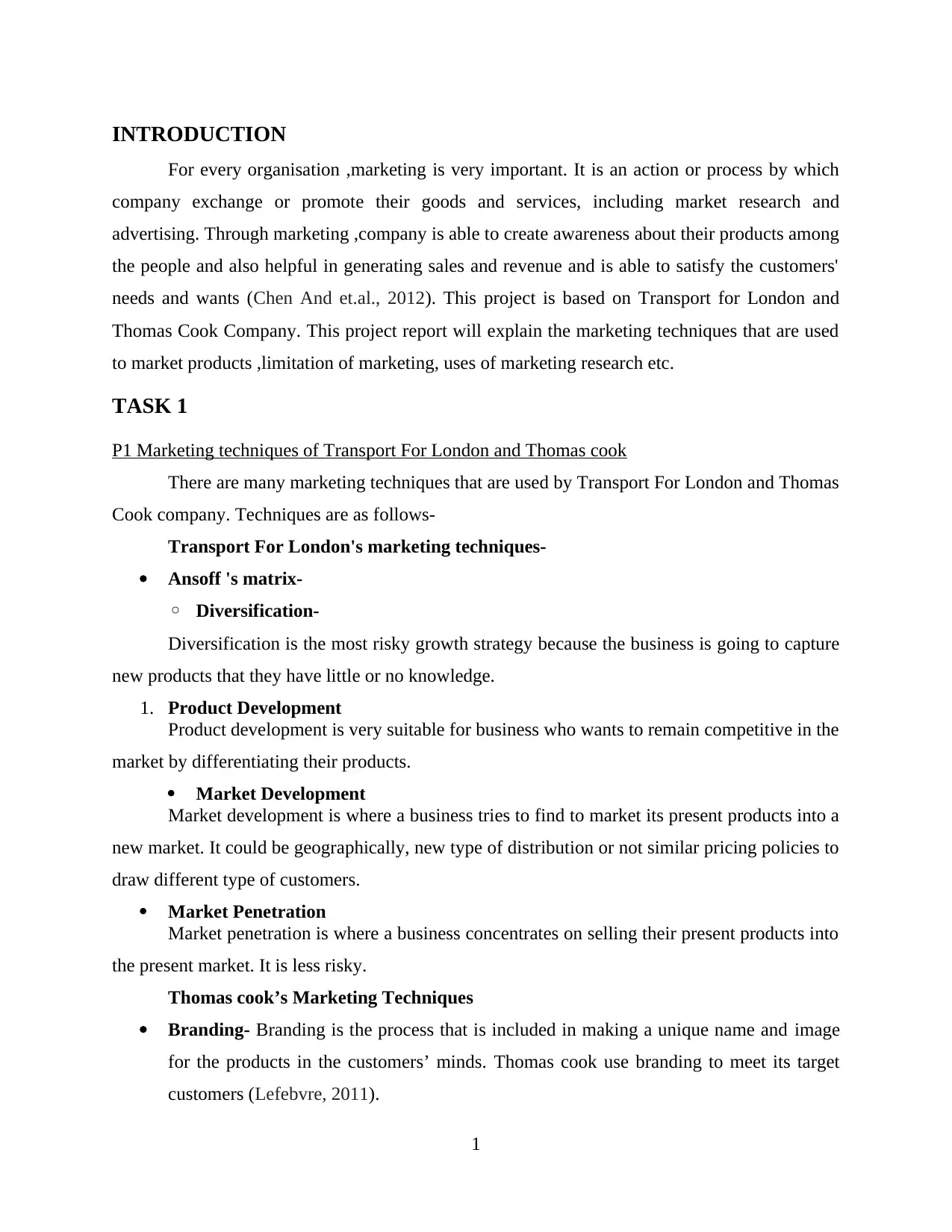
INTRODUCTION
For every organisation ,marketing is very important. It is an action or process by which
company exchange or promote their goods and services, including market research and
advertising. Through marketing ,company is able to create awareness about their products among
the people and also helpful in generating sales and revenue and is able to satisfy the customers'
needs and wants (Chen And et.al., 2012). This project is based on Transport for London and
Thomas Cook Company. This project report will explain the marketing techniques that are used
to market products ,limitation of marketing, uses of marketing research etc.
TASK 1
P1 Marketing techniques of Transport For London and Thomas cook
There are many marketing techniques that are used by Transport For London and Thomas
Cook company. Techniques are as follows-
Transport For London's marketing techniques-
Ansoff 's matrix-
◦ Diversification-
Diversification is the most risky growth strategy because the business is going to capture
new products that they have little or no knowledge.
1. Product Development
Product development is very suitable for business who wants to remain competitive in the
market by differentiating their products.
Market Development
Market development is where a business tries to find to market its present products into a
new market. It could be geographically, new type of distribution or not similar pricing policies to
draw different type of customers.
Market Penetration
Market penetration is where a business concentrates on selling their present products into
the present market. It is less risky.
Thomas cook’s Marketing Techniques
Branding- Branding is the process that is included in making a unique name and image
for the products in the customers’ minds. Thomas cook use branding to meet its target
customers (Lefebvre, 2011).
1
For every organisation ,marketing is very important. It is an action or process by which
company exchange or promote their goods and services, including market research and
advertising. Through marketing ,company is able to create awareness about their products among
the people and also helpful in generating sales and revenue and is able to satisfy the customers'
needs and wants (Chen And et.al., 2012). This project is based on Transport for London and
Thomas Cook Company. This project report will explain the marketing techniques that are used
to market products ,limitation of marketing, uses of marketing research etc.
TASK 1
P1 Marketing techniques of Transport For London and Thomas cook
There are many marketing techniques that are used by Transport For London and Thomas
Cook company. Techniques are as follows-
Transport For London's marketing techniques-
Ansoff 's matrix-
◦ Diversification-
Diversification is the most risky growth strategy because the business is going to capture
new products that they have little or no knowledge.
1. Product Development
Product development is very suitable for business who wants to remain competitive in the
market by differentiating their products.
Market Development
Market development is where a business tries to find to market its present products into a
new market. It could be geographically, new type of distribution or not similar pricing policies to
draw different type of customers.
Market Penetration
Market penetration is where a business concentrates on selling their present products into
the present market. It is less risky.
Thomas cook’s Marketing Techniques
Branding- Branding is the process that is included in making a unique name and image
for the products in the customers’ minds. Thomas cook use branding to meet its target
customers (Lefebvre, 2011).
1
⊘ This is a preview!⊘
Do you want full access?
Subscribe today to unlock all pages.

Trusted by 1+ million students worldwide
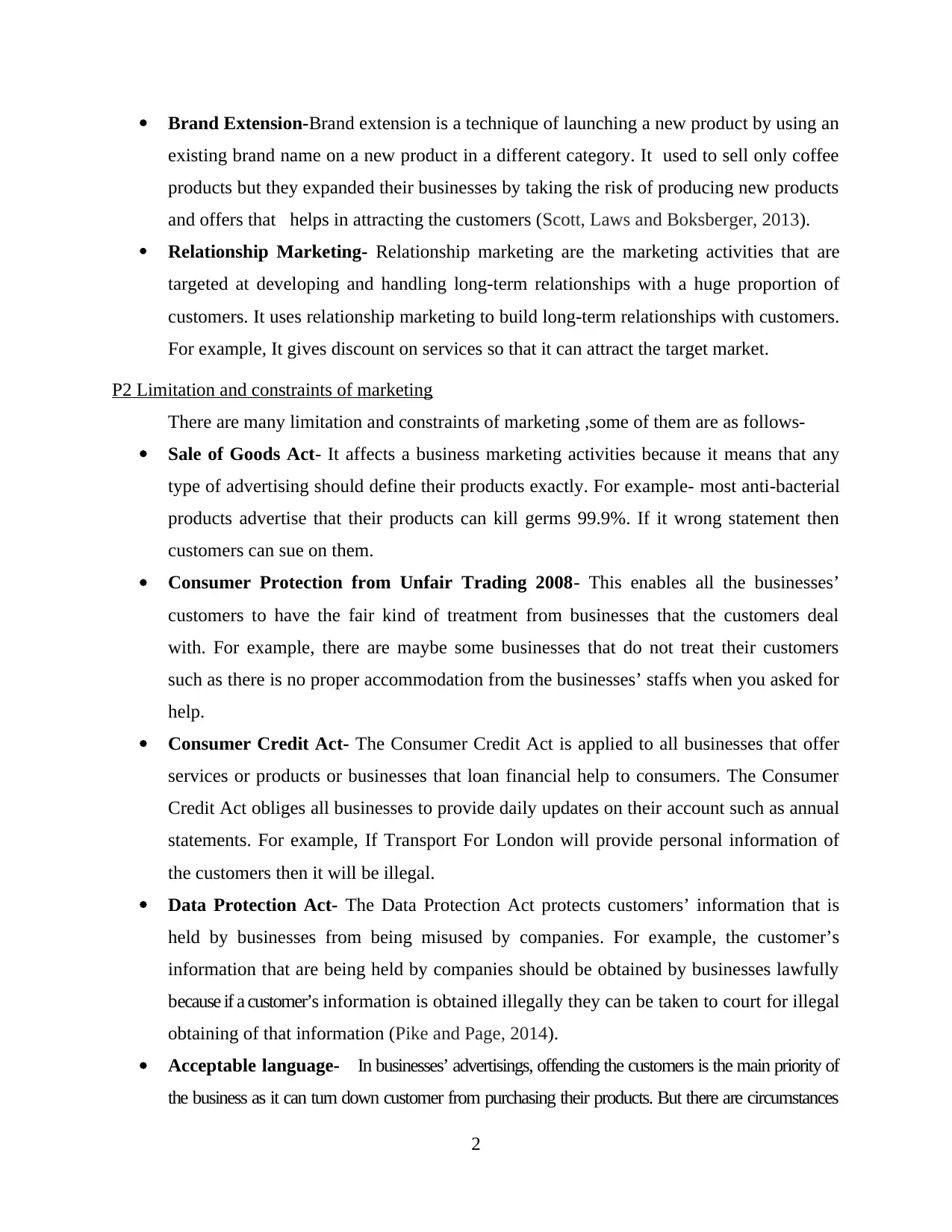
Brand Extension-Brand extension is a technique of launching a new product by using an
existing brand name on a new product in a different category. It used to sell only coffee
products but they expanded their businesses by taking the risk of producing new products
and offers that helps in attracting the customers (Scott, Laws and Boksberger, 2013).
Relationship Marketing- Relationship marketing are the marketing activities that are
targeted at developing and handling long-term relationships with a huge proportion of
customers. It uses relationship marketing to build long-term relationships with customers.
For example, It gives discount on services so that it can attract the target market.
P2 Limitation and constraints of marketing
There are many limitation and constraints of marketing ,some of them are as follows-
Sale of Goods Act- It affects a business marketing activities because it means that any
type of advertising should define their products exactly. For example- most anti-bacterial
products advertise that their products can kill germs 99.9%. If it wrong statement then
customers can sue on them.
Consumer Protection from Unfair Trading 2008- This enables all the businesses’
customers to have the fair kind of treatment from businesses that the customers deal
with. For example, there are maybe some businesses that do not treat their customers
such as there is no proper accommodation from the businesses’ staffs when you asked for
help.
Consumer Credit Act- The Consumer Credit Act is applied to all businesses that offer
services or products or businesses that loan financial help to consumers. The Consumer
Credit Act obliges all businesses to provide daily updates on their account such as annual
statements. For example, If Transport For London will provide personal information of
the customers then it will be illegal.
Data Protection Act- The Data Protection Act protects customers’ information that is
held by businesses from being misused by companies. For example, the customer’s
information that are being held by companies should be obtained by businesses lawfully
because if a customer’s information is obtained illegally they can be taken to court for illegal
obtaining of that information (Pike and Page, 2014).
Acceptable language- In businesses’ advertisings, offending the customers is the main priority of
the business as it can turn down customer from purchasing their products. But there are circumstances
2
existing brand name on a new product in a different category. It used to sell only coffee
products but they expanded their businesses by taking the risk of producing new products
and offers that helps in attracting the customers (Scott, Laws and Boksberger, 2013).
Relationship Marketing- Relationship marketing are the marketing activities that are
targeted at developing and handling long-term relationships with a huge proportion of
customers. It uses relationship marketing to build long-term relationships with customers.
For example, It gives discount on services so that it can attract the target market.
P2 Limitation and constraints of marketing
There are many limitation and constraints of marketing ,some of them are as follows-
Sale of Goods Act- It affects a business marketing activities because it means that any
type of advertising should define their products exactly. For example- most anti-bacterial
products advertise that their products can kill germs 99.9%. If it wrong statement then
customers can sue on them.
Consumer Protection from Unfair Trading 2008- This enables all the businesses’
customers to have the fair kind of treatment from businesses that the customers deal
with. For example, there are maybe some businesses that do not treat their customers
such as there is no proper accommodation from the businesses’ staffs when you asked for
help.
Consumer Credit Act- The Consumer Credit Act is applied to all businesses that offer
services or products or businesses that loan financial help to consumers. The Consumer
Credit Act obliges all businesses to provide daily updates on their account such as annual
statements. For example, If Transport For London will provide personal information of
the customers then it will be illegal.
Data Protection Act- The Data Protection Act protects customers’ information that is
held by businesses from being misused by companies. For example, the customer’s
information that are being held by companies should be obtained by businesses lawfully
because if a customer’s information is obtained illegally they can be taken to court for illegal
obtaining of that information (Pike and Page, 2014).
Acceptable language- In businesses’ advertisings, offending the customers is the main priority of
the business as it can turn down customer from purchasing their products. But there are circumstances
2
Paraphrase This Document
Need a fresh take? Get an instant paraphrase of this document with our AI Paraphraser
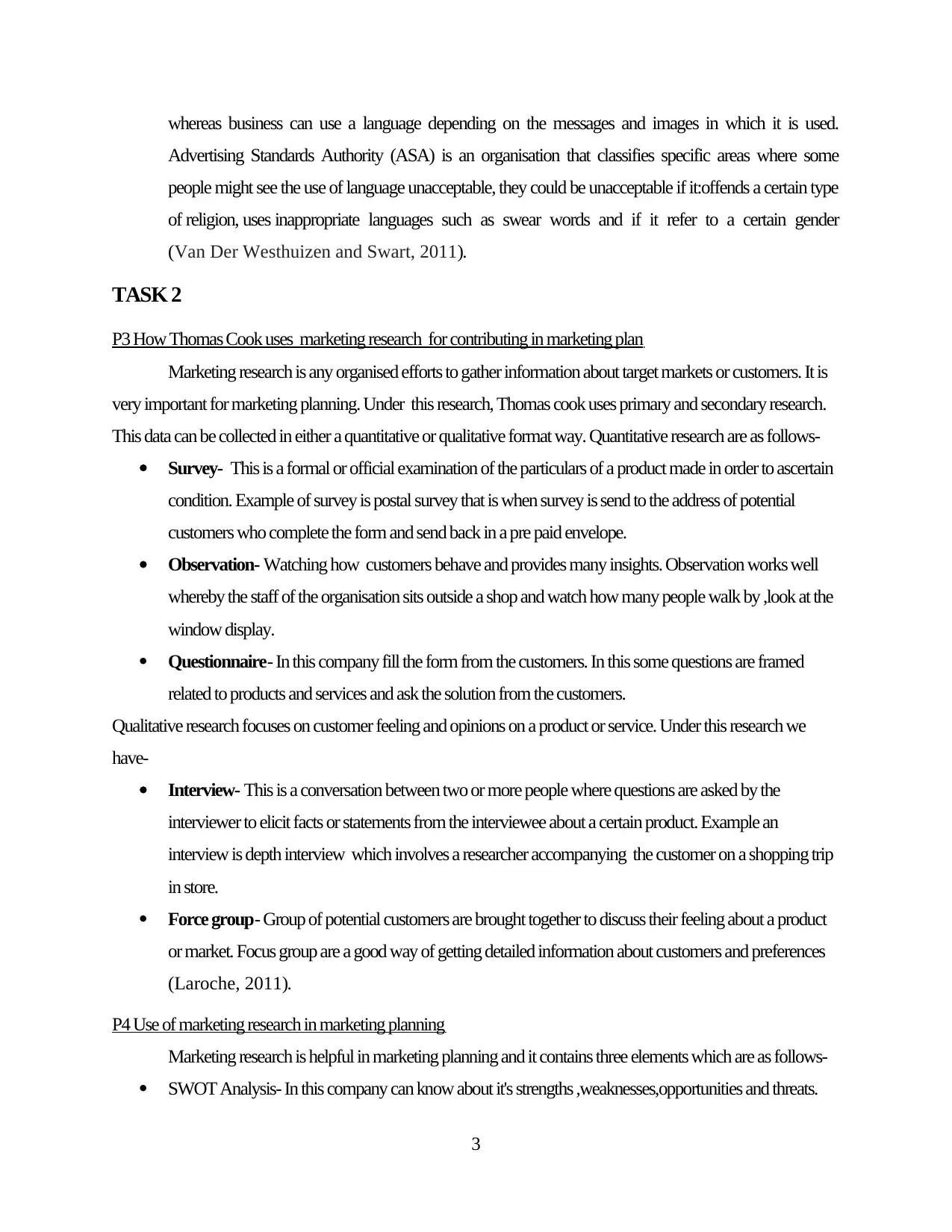
whereas business can use a language depending on the messages and images in which it is used.
Advertising Standards Authority (ASA) is an organisation that classifies specific areas where some
people might see the use of language unacceptable, they could be unacceptable if it:offends a certain type
of religion, uses inappropriate languages such as swear words and if it refer to a certain gender
(Van Der Westhuizen and Swart, 2011).
TASK 2
P3 How Thomas Cook uses marketing research for contributing in marketing plan
Marketing research is any organised efforts to gather information about target markets or customers. It is
very important for marketing planning. Under this research, Thomas cook uses primary and secondary research.
This data can be collected in either a quantitative or qualitative format way. Quantitative research are as follows-
Survey- This is a formal or official examination of the particulars of a product made in order to ascertain
condition. Example of survey is postal survey that is when survey is send to the address of potential
customers who complete the form and send back in a pre paid envelope.
Observation- Watching how customers behave and provides many insights. Observation works well
whereby the staff of the organisation sits outside a shop and watch how many people walk by ,look at the
window display.
Questionnaire- In this company fill the form from the customers. In this some questions are framed
related to products and services and ask the solution from the customers.
Qualitative research focuses on customer feeling and opinions on a product or service. Under this research we
have-
Interview- This is a conversation between two or more people where questions are asked by the
interviewer to elicit facts or statements from the interviewee about a certain product. Example an
interview is depth interview which involves a researcher accompanying the customer on a shopping trip
in store.
Force group- Group of potential customers are brought together to discuss their feeling about a product
or market. Focus group are a good way of getting detailed information about customers and preferences
(Laroche, 2011).
P4 Use of marketing research in marketing planning
Marketing research is helpful in marketing planning and it contains three elements which are as follows-
SWOT Analysis- In this company can know about it's strengths ,weaknesses,opportunities and threats.
3
Advertising Standards Authority (ASA) is an organisation that classifies specific areas where some
people might see the use of language unacceptable, they could be unacceptable if it:offends a certain type
of religion, uses inappropriate languages such as swear words and if it refer to a certain gender
(Van Der Westhuizen and Swart, 2011).
TASK 2
P3 How Thomas Cook uses marketing research for contributing in marketing plan
Marketing research is any organised efforts to gather information about target markets or customers. It is
very important for marketing planning. Under this research, Thomas cook uses primary and secondary research.
This data can be collected in either a quantitative or qualitative format way. Quantitative research are as follows-
Survey- This is a formal or official examination of the particulars of a product made in order to ascertain
condition. Example of survey is postal survey that is when survey is send to the address of potential
customers who complete the form and send back in a pre paid envelope.
Observation- Watching how customers behave and provides many insights. Observation works well
whereby the staff of the organisation sits outside a shop and watch how many people walk by ,look at the
window display.
Questionnaire- In this company fill the form from the customers. In this some questions are framed
related to products and services and ask the solution from the customers.
Qualitative research focuses on customer feeling and opinions on a product or service. Under this research we
have-
Interview- This is a conversation between two or more people where questions are asked by the
interviewer to elicit facts or statements from the interviewee about a certain product. Example an
interview is depth interview which involves a researcher accompanying the customer on a shopping trip
in store.
Force group- Group of potential customers are brought together to discuss their feeling about a product
or market. Focus group are a good way of getting detailed information about customers and preferences
(Laroche, 2011).
P4 Use of marketing research in marketing planning
Marketing research is helpful in marketing planning and it contains three elements which are as follows-
SWOT Analysis- In this company can know about it's strengths ,weaknesses,opportunities and threats.
3
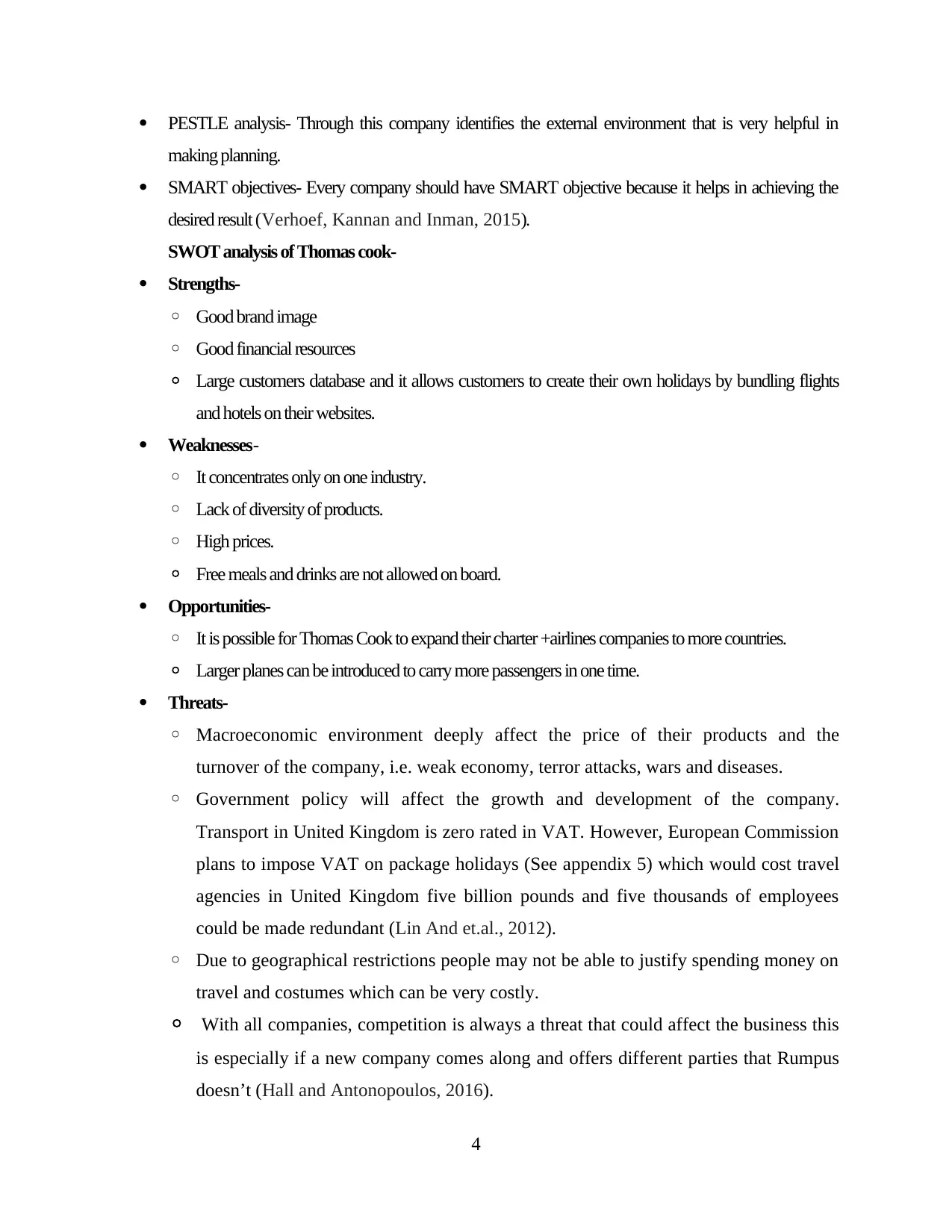
PESTLE analysis- Through this company identifies the external environment that is very helpful in
making planning.
SMART objectives- Every company should have SMART objective because it helps in achieving the
desired result (Verhoef, Kannan and Inman, 2015).
SWOT analysis of Thomas cook-
Strengths-
◦ Good brand image
◦ Good financial resources
◦ Large customers database and it allows customers to create their own holidays by bundling flights
and hotels on their websites.
Weaknesses-
◦ It concentrates only on one industry.
◦ Lack of diversity of products.
◦ High prices.
◦ Free meals and drinks are not allowed on board.
Opportunities-
◦ It is possible for Thomas Cook to expand their charter +airlines companies to more countries.
◦ Larger planes can be introduced to carry more passengers in one time.
Threats-
◦ Macroeconomic environment deeply affect the price of their products and the
turnover of the company, i.e. weak economy, terror attacks, wars and diseases.
◦ Government policy will affect the growth and development of the company.
Transport in United Kingdom is zero rated in VAT. However, European Commission
plans to impose VAT on package holidays (See appendix 5) which would cost travel
agencies in United Kingdom five billion pounds and five thousands of employees
could be made redundant (Lin And et.al., 2012).
◦ Due to geographical restrictions people may not be able to justify spending money on
travel and costumes which can be very costly.
◦ With all companies, competition is always a threat that could affect the business this
is especially if a new company comes along and offers different parties that Rumpus
doesn’t (Hall and Antonopoulos, 2016).
4
making planning.
SMART objectives- Every company should have SMART objective because it helps in achieving the
desired result (Verhoef, Kannan and Inman, 2015).
SWOT analysis of Thomas cook-
Strengths-
◦ Good brand image
◦ Good financial resources
◦ Large customers database and it allows customers to create their own holidays by bundling flights
and hotels on their websites.
Weaknesses-
◦ It concentrates only on one industry.
◦ Lack of diversity of products.
◦ High prices.
◦ Free meals and drinks are not allowed on board.
Opportunities-
◦ It is possible for Thomas Cook to expand their charter +airlines companies to more countries.
◦ Larger planes can be introduced to carry more passengers in one time.
Threats-
◦ Macroeconomic environment deeply affect the price of their products and the
turnover of the company, i.e. weak economy, terror attacks, wars and diseases.
◦ Government policy will affect the growth and development of the company.
Transport in United Kingdom is zero rated in VAT. However, European Commission
plans to impose VAT on package holidays (See appendix 5) which would cost travel
agencies in United Kingdom five billion pounds and five thousands of employees
could be made redundant (Lin And et.al., 2012).
◦ Due to geographical restrictions people may not be able to justify spending money on
travel and costumes which can be very costly.
◦ With all companies, competition is always a threat that could affect the business this
is especially if a new company comes along and offers different parties that Rumpus
doesn’t (Hall and Antonopoulos, 2016).
4
⊘ This is a preview!⊘
Do you want full access?
Subscribe today to unlock all pages.

Trusted by 1+ million students worldwide
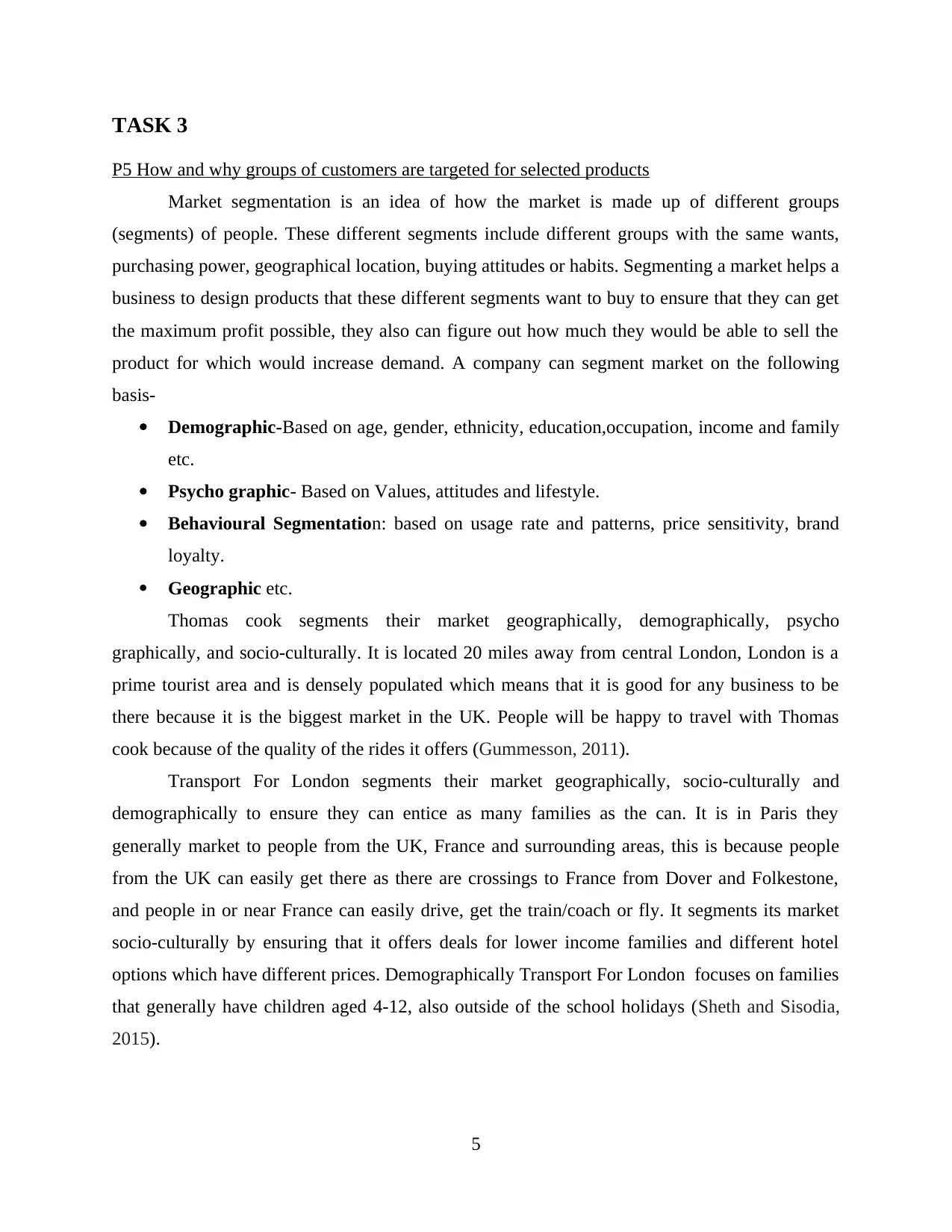
TASK 3
P5 How and why groups of customers are targeted for selected products
Market segmentation is an idea of how the market is made up of different groups
(segments) of people. These different segments include different groups with the same wants,
purchasing power, geographical location, buying attitudes or habits. Segmenting a market helps a
business to design products that these different segments want to buy to ensure that they can get
the maximum profit possible, they also can figure out how much they would be able to sell the
product for which would increase demand. A company can segment market on the following
basis-
Demographic-Based on age, gender, ethnicity, education,occupation, income and family
etc.
Psycho graphic- Based on Values, attitudes and lifestyle.
Behavioural Segmentation: based on usage rate and patterns, price sensitivity, brand
loyalty.
Geographic etc.
Thomas cook segments their market geographically, demographically, psycho
graphically, and socio-culturally. It is located 20 miles away from central London, London is a
prime tourist area and is densely populated which means that it is good for any business to be
there because it is the biggest market in the UK. People will be happy to travel with Thomas
cook because of the quality of the rides it offers (Gummesson, 2011).
Transport For London segments their market geographically, socio-culturally and
demographically to ensure they can entice as many families as the can. It is in Paris they
generally market to people from the UK, France and surrounding areas, this is because people
from the UK can easily get there as there are crossings to France from Dover and Folkestone,
and people in or near France can easily drive, get the train/coach or fly. It segments its market
socio-culturally by ensuring that it offers deals for lower income families and different hotel
options which have different prices. Demographically Transport For London focuses on families
that generally have children aged 4-12, also outside of the school holidays (Sheth and Sisodia,
2015).
5
P5 How and why groups of customers are targeted for selected products
Market segmentation is an idea of how the market is made up of different groups
(segments) of people. These different segments include different groups with the same wants,
purchasing power, geographical location, buying attitudes or habits. Segmenting a market helps a
business to design products that these different segments want to buy to ensure that they can get
the maximum profit possible, they also can figure out how much they would be able to sell the
product for which would increase demand. A company can segment market on the following
basis-
Demographic-Based on age, gender, ethnicity, education,occupation, income and family
etc.
Psycho graphic- Based on Values, attitudes and lifestyle.
Behavioural Segmentation: based on usage rate and patterns, price sensitivity, brand
loyalty.
Geographic etc.
Thomas cook segments their market geographically, demographically, psycho
graphically, and socio-culturally. It is located 20 miles away from central London, London is a
prime tourist area and is densely populated which means that it is good for any business to be
there because it is the biggest market in the UK. People will be happy to travel with Thomas
cook because of the quality of the rides it offers (Gummesson, 2011).
Transport For London segments their market geographically, socio-culturally and
demographically to ensure they can entice as many families as the can. It is in Paris they
generally market to people from the UK, France and surrounding areas, this is because people
from the UK can easily get there as there are crossings to France from Dover and Folkestone,
and people in or near France can easily drive, get the train/coach or fly. It segments its market
socio-culturally by ensuring that it offers deals for lower income families and different hotel
options which have different prices. Demographically Transport For London focuses on families
that generally have children aged 4-12, also outside of the school holidays (Sheth and Sisodia,
2015).
5
Paraphrase This Document
Need a fresh take? Get an instant paraphrase of this document with our AI Paraphraser
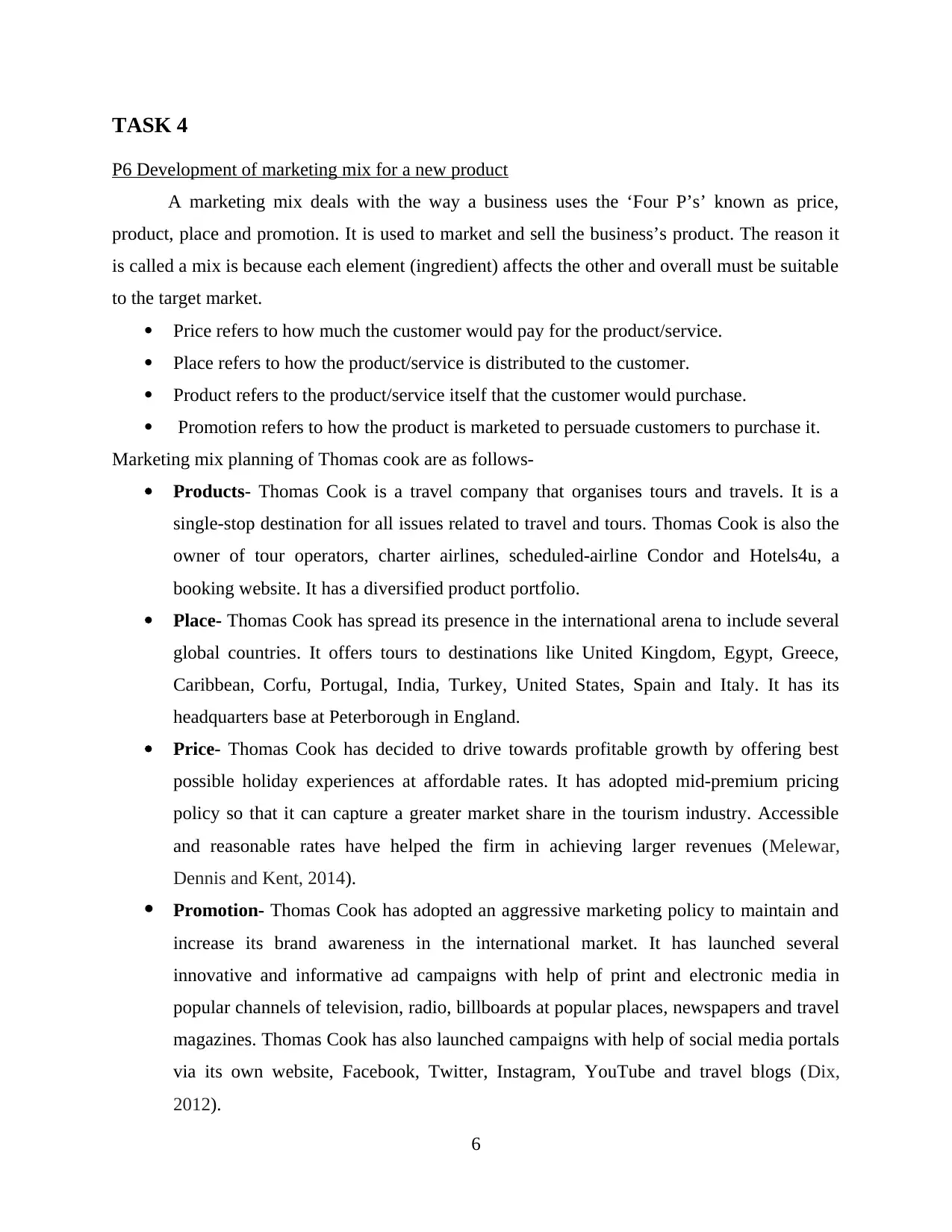
TASK 4
P6 Development of marketing mix for a new product
A marketing mix deals with the way a business uses the ‘Four P’s’ known as price,
product, place and promotion. It is used to market and sell the business’s product. The reason it
is called a mix is because each element (ingredient) affects the other and overall must be suitable
to the target market.
Price refers to how much the customer would pay for the product/service.
Place refers to how the product/service is distributed to the customer.
Product refers to the product/service itself that the customer would purchase.
Promotion refers to how the product is marketed to persuade customers to purchase it.
Marketing mix planning of Thomas cook are as follows-
Products- Thomas Cook is a travel company that organises tours and travels. It is a
single-stop destination for all issues related to travel and tours. Thomas Cook is also the
owner of tour operators, charter airlines, scheduled-airline Condor and Hotels4u, a
booking website. It has a diversified product portfolio.
Place- Thomas Cook has spread its presence in the international arena to include several
global countries. It offers tours to destinations like United Kingdom, Egypt, Greece,
Caribbean, Corfu, Portugal, India, Turkey, United States, Spain and Italy. It has its
headquarters base at Peterborough in England.
Price- Thomas Cook has decided to drive towards profitable growth by offering best
possible holiday experiences at affordable rates. It has adopted mid-premium pricing
policy so that it can capture a greater market share in the tourism industry. Accessible
and reasonable rates have helped the firm in achieving larger revenues (Melewar,
Dennis and Kent, 2014).
Promotion- Thomas Cook has adopted an aggressive marketing policy to maintain and
increase its brand awareness in the international market. It has launched several
innovative and informative ad campaigns with help of print and electronic media in
popular channels of television, radio, billboards at popular places, newspapers and travel
magazines. Thomas Cook has also launched campaigns with help of social media portals
via its own website, Facebook, Twitter, Instagram, YouTube and travel blogs (Dix,
2012).
6
P6 Development of marketing mix for a new product
A marketing mix deals with the way a business uses the ‘Four P’s’ known as price,
product, place and promotion. It is used to market and sell the business’s product. The reason it
is called a mix is because each element (ingredient) affects the other and overall must be suitable
to the target market.
Price refers to how much the customer would pay for the product/service.
Place refers to how the product/service is distributed to the customer.
Product refers to the product/service itself that the customer would purchase.
Promotion refers to how the product is marketed to persuade customers to purchase it.
Marketing mix planning of Thomas cook are as follows-
Products- Thomas Cook is a travel company that organises tours and travels. It is a
single-stop destination for all issues related to travel and tours. Thomas Cook is also the
owner of tour operators, charter airlines, scheduled-airline Condor and Hotels4u, a
booking website. It has a diversified product portfolio.
Place- Thomas Cook has spread its presence in the international arena to include several
global countries. It offers tours to destinations like United Kingdom, Egypt, Greece,
Caribbean, Corfu, Portugal, India, Turkey, United States, Spain and Italy. It has its
headquarters base at Peterborough in England.
Price- Thomas Cook has decided to drive towards profitable growth by offering best
possible holiday experiences at affordable rates. It has adopted mid-premium pricing
policy so that it can capture a greater market share in the tourism industry. Accessible
and reasonable rates have helped the firm in achieving larger revenues (Melewar,
Dennis and Kent, 2014).
Promotion- Thomas Cook has adopted an aggressive marketing policy to maintain and
increase its brand awareness in the international market. It has launched several
innovative and informative ad campaigns with help of print and electronic media in
popular channels of television, radio, billboards at popular places, newspapers and travel
magazines. Thomas Cook has also launched campaigns with help of social media portals
via its own website, Facebook, Twitter, Instagram, YouTube and travel blogs (Dix,
2012).
6
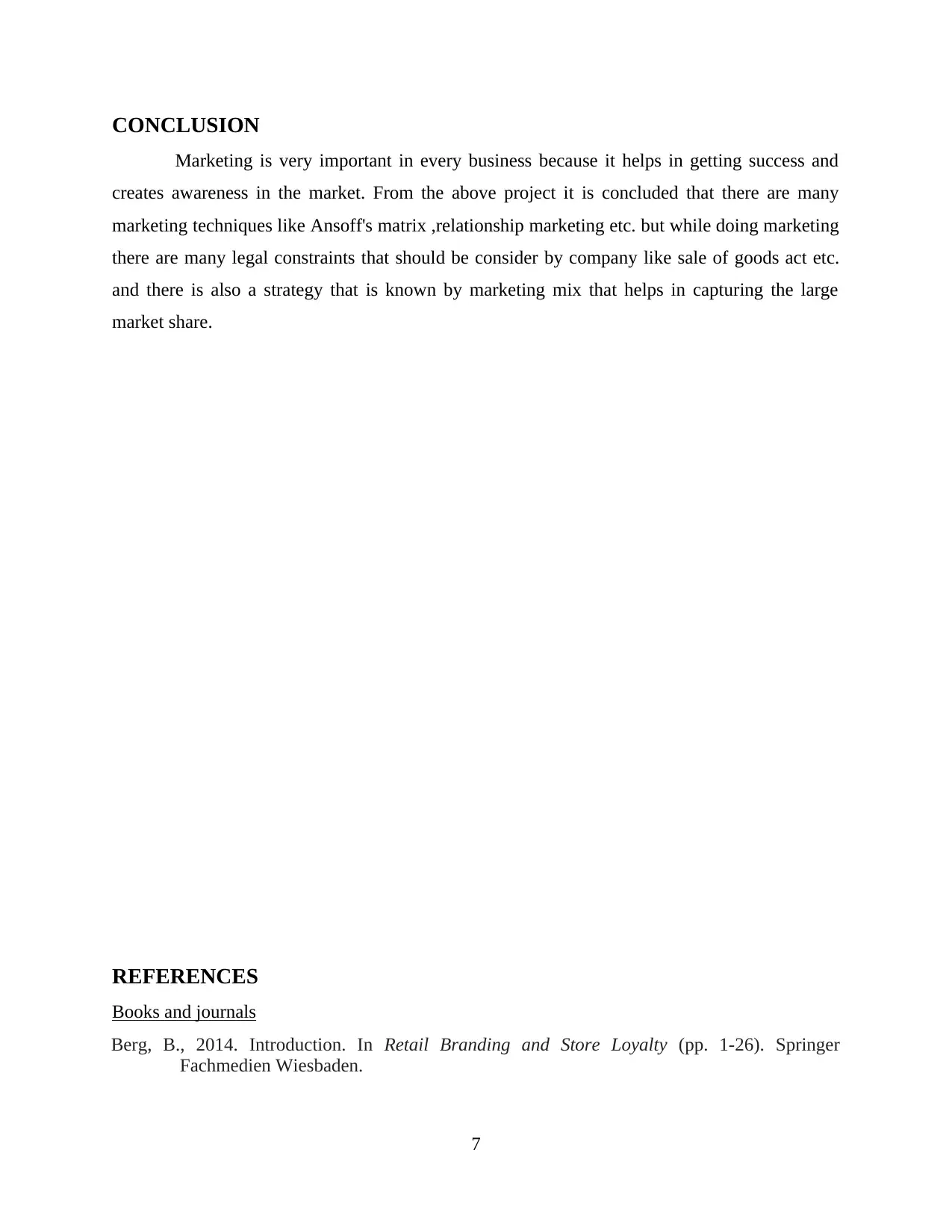
CONCLUSION
Marketing is very important in every business because it helps in getting success and
creates awareness in the market. From the above project it is concluded that there are many
marketing techniques like Ansoff's matrix ,relationship marketing etc. but while doing marketing
there are many legal constraints that should be consider by company like sale of goods act etc.
and there is also a strategy that is known by marketing mix that helps in capturing the large
market share.
REFERENCES
Books and journals
Berg, B., 2014. Introduction. In Retail Branding and Store Loyalty (pp. 1-26). Springer
Fachmedien Wiesbaden.
7
Marketing is very important in every business because it helps in getting success and
creates awareness in the market. From the above project it is concluded that there are many
marketing techniques like Ansoff's matrix ,relationship marketing etc. but while doing marketing
there are many legal constraints that should be consider by company like sale of goods act etc.
and there is also a strategy that is known by marketing mix that helps in capturing the large
market share.
REFERENCES
Books and journals
Berg, B., 2014. Introduction. In Retail Branding and Store Loyalty (pp. 1-26). Springer
Fachmedien Wiesbaden.
7
⊘ This is a preview!⊘
Do you want full access?
Subscribe today to unlock all pages.

Trusted by 1+ million students worldwide
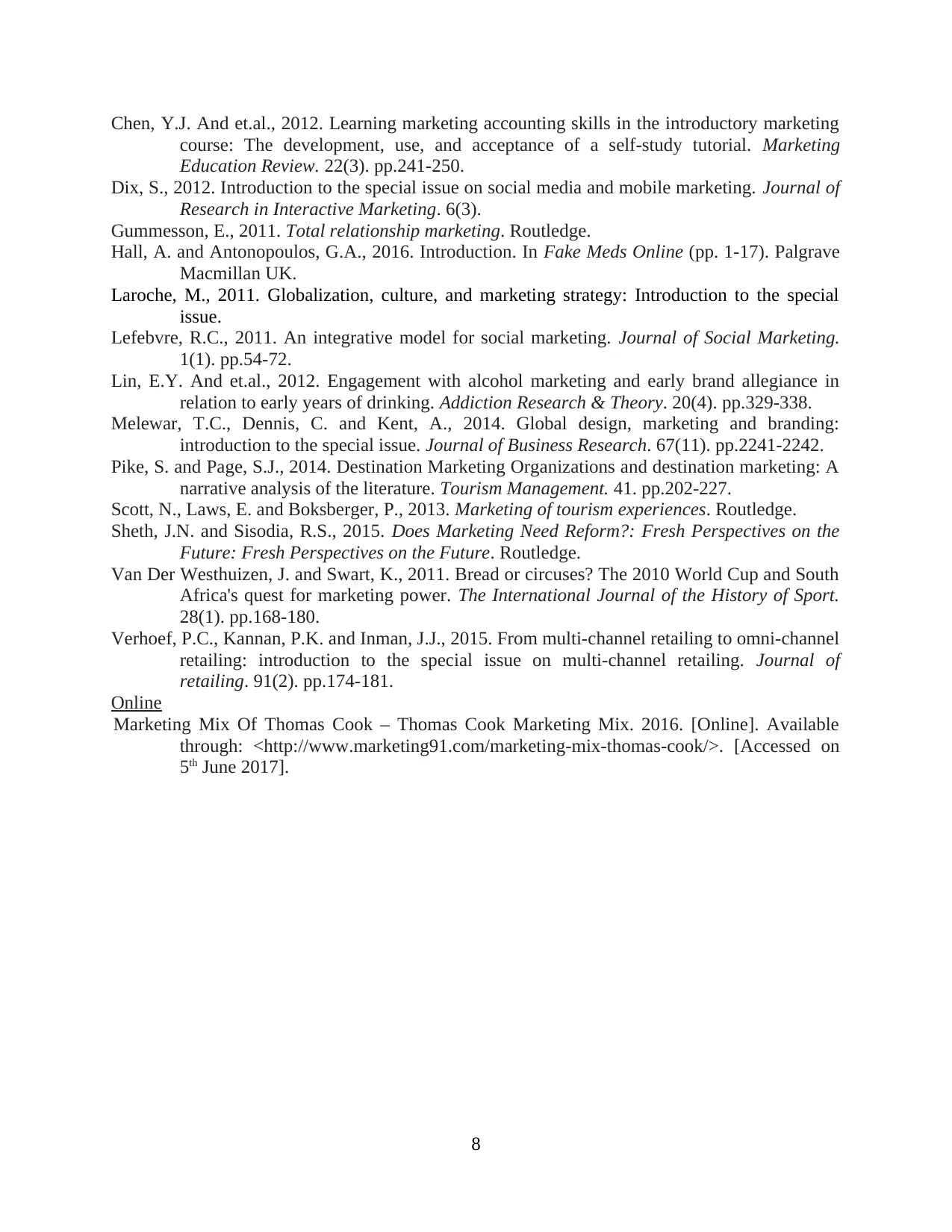
Chen, Y.J. And et.al., 2012. Learning marketing accounting skills in the introductory marketing
course: The development, use, and acceptance of a self-study tutorial. Marketing
Education Review. 22(3). pp.241-250.
Dix, S., 2012. Introduction to the special issue on social media and mobile marketing. Journal of
Research in Interactive Marketing. 6(3).
Gummesson, E., 2011. Total relationship marketing. Routledge.
Hall, A. and Antonopoulos, G.A., 2016. Introduction. In Fake Meds Online (pp. 1-17). Palgrave
Macmillan UK.
Laroche, M., 2011. Globalization, culture, and marketing strategy: Introduction to the special
issue.
Lefebvre, R.C., 2011. An integrative model for social marketing. Journal of Social Marketing.
1(1). pp.54-72.
Lin, E.Y. And et.al., 2012. Engagement with alcohol marketing and early brand allegiance in
relation to early years of drinking. Addiction Research & Theory. 20(4). pp.329-338.
Melewar, T.C., Dennis, C. and Kent, A., 2014. Global design, marketing and branding:
introduction to the special issue. Journal of Business Research. 67(11). pp.2241-2242.
Pike, S. and Page, S.J., 2014. Destination Marketing Organizations and destination marketing: A
narrative analysis of the literature. Tourism Management. 41. pp.202-227.
Scott, N., Laws, E. and Boksberger, P., 2013. Marketing of tourism experiences. Routledge.
Sheth, J.N. and Sisodia, R.S., 2015. Does Marketing Need Reform?: Fresh Perspectives on the
Future: Fresh Perspectives on the Future. Routledge.
Van Der Westhuizen, J. and Swart, K., 2011. Bread or circuses? The 2010 World Cup and South
Africa's quest for marketing power. The International Journal of the History of Sport.
28(1). pp.168-180.
Verhoef, P.C., Kannan, P.K. and Inman, J.J., 2015. From multi-channel retailing to omni-channel
retailing: introduction to the special issue on multi-channel retailing. Journal of
retailing. 91(2). pp.174-181.
Online
Marketing Mix Of Thomas Cook – Thomas Cook Marketing Mix. 2016. [Online]. Available
through: <http://www.marketing91.com/marketing-mix-thomas-cook/>. [Accessed on
5th June 2017].
8
course: The development, use, and acceptance of a self-study tutorial. Marketing
Education Review. 22(3). pp.241-250.
Dix, S., 2012. Introduction to the special issue on social media and mobile marketing. Journal of
Research in Interactive Marketing. 6(3).
Gummesson, E., 2011. Total relationship marketing. Routledge.
Hall, A. and Antonopoulos, G.A., 2016. Introduction. In Fake Meds Online (pp. 1-17). Palgrave
Macmillan UK.
Laroche, M., 2011. Globalization, culture, and marketing strategy: Introduction to the special
issue.
Lefebvre, R.C., 2011. An integrative model for social marketing. Journal of Social Marketing.
1(1). pp.54-72.
Lin, E.Y. And et.al., 2012. Engagement with alcohol marketing and early brand allegiance in
relation to early years of drinking. Addiction Research & Theory. 20(4). pp.329-338.
Melewar, T.C., Dennis, C. and Kent, A., 2014. Global design, marketing and branding:
introduction to the special issue. Journal of Business Research. 67(11). pp.2241-2242.
Pike, S. and Page, S.J., 2014. Destination Marketing Organizations and destination marketing: A
narrative analysis of the literature. Tourism Management. 41. pp.202-227.
Scott, N., Laws, E. and Boksberger, P., 2013. Marketing of tourism experiences. Routledge.
Sheth, J.N. and Sisodia, R.S., 2015. Does Marketing Need Reform?: Fresh Perspectives on the
Future: Fresh Perspectives on the Future. Routledge.
Van Der Westhuizen, J. and Swart, K., 2011. Bread or circuses? The 2010 World Cup and South
Africa's quest for marketing power. The International Journal of the History of Sport.
28(1). pp.168-180.
Verhoef, P.C., Kannan, P.K. and Inman, J.J., 2015. From multi-channel retailing to omni-channel
retailing: introduction to the special issue on multi-channel retailing. Journal of
retailing. 91(2). pp.174-181.
Online
Marketing Mix Of Thomas Cook – Thomas Cook Marketing Mix. 2016. [Online]. Available
through: <http://www.marketing91.com/marketing-mix-thomas-cook/>. [Accessed on
5th June 2017].
8
1 out of 10
Related Documents
Your All-in-One AI-Powered Toolkit for Academic Success.
+13062052269
info@desklib.com
Available 24*7 on WhatsApp / Email
![[object Object]](/_next/static/media/star-bottom.7253800d.svg)
Unlock your academic potential
Copyright © 2020–2025 A2Z Services. All Rights Reserved. Developed and managed by ZUCOL.





